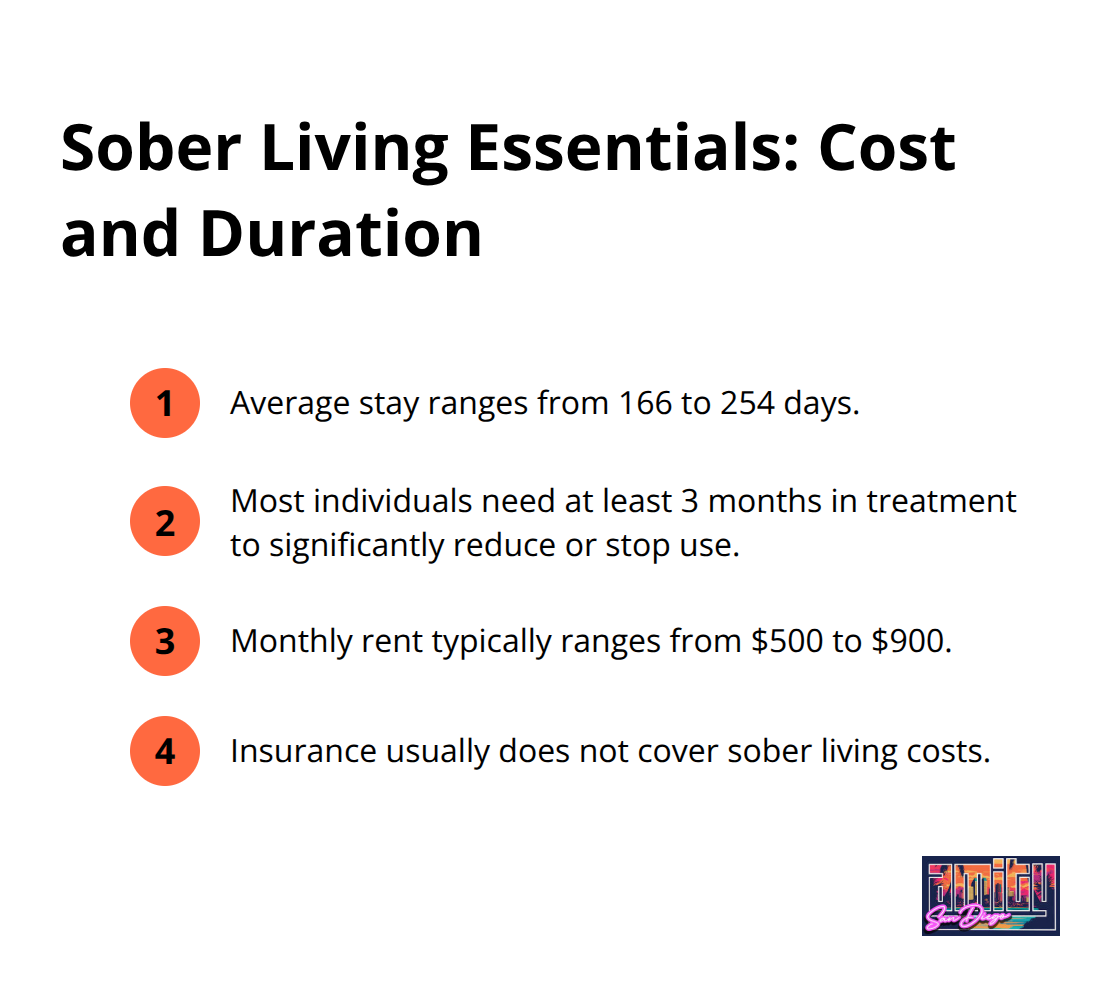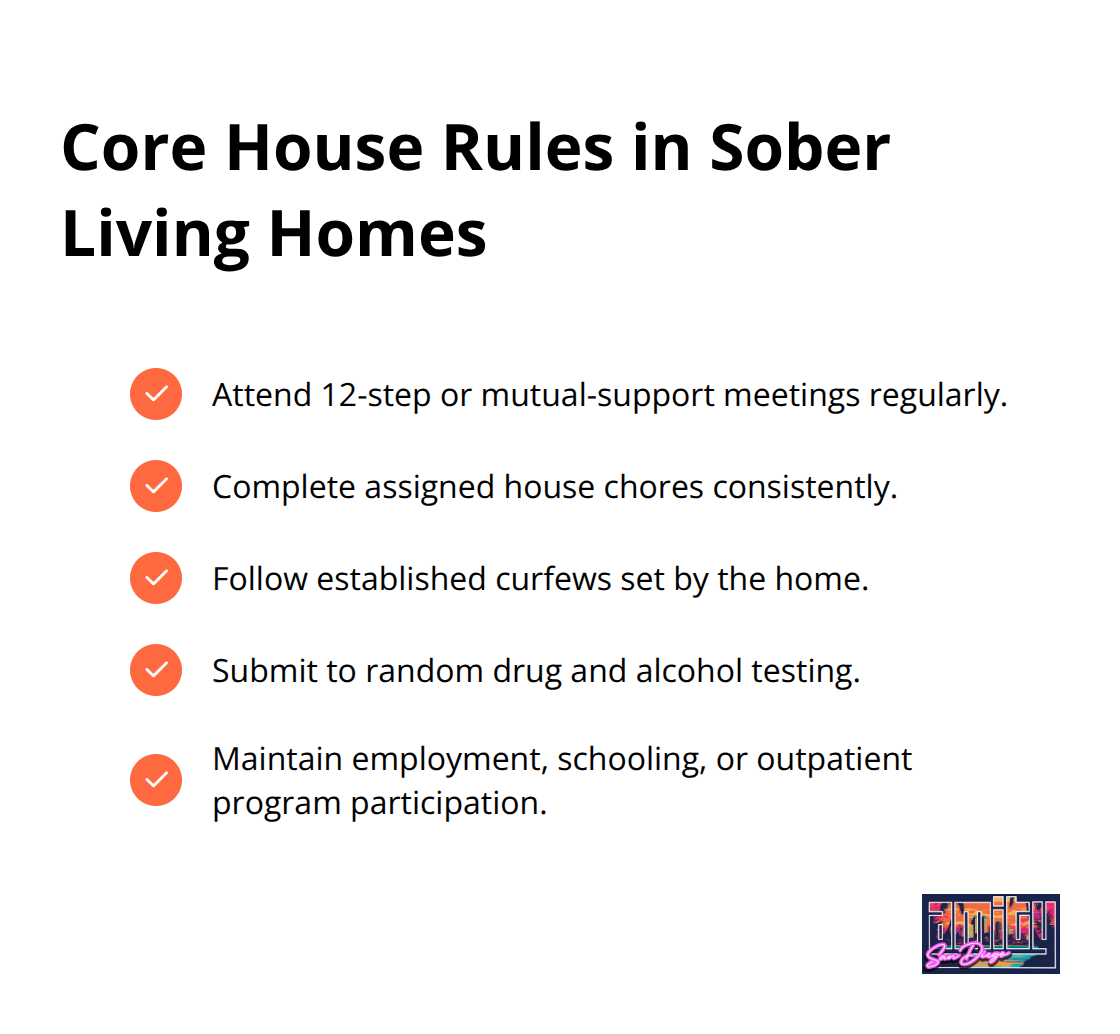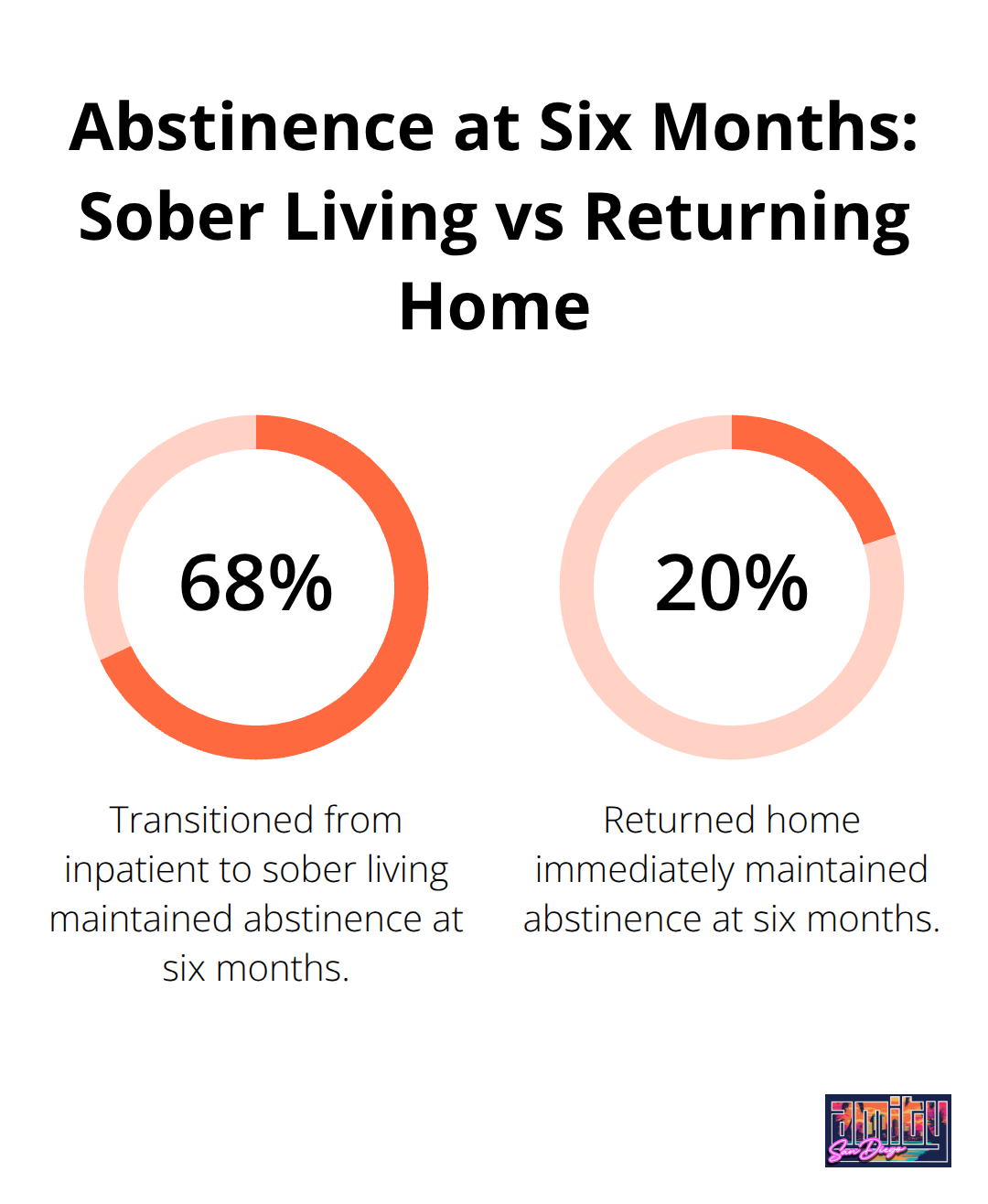Recovery doesn’t end when treatment finishes. Many people need continued support to maintain their sobriety and build independent living skills.
We at Amity San Diego understand that the question “what is a sober living home?” comes up frequently for those planning their recovery journey. These structured environments bridge the gap between intensive treatment and complete independence.
What Exactly Is a Sober Living Home
A sober living home functions as a residential facility that provides alcohol and drug-free environments for individuals in recovery. These homes require residents to pay rent and maintain complete sobriety as conditions of residency. Research from the Journal of Psychoactive Drugs demonstrates that residents experience significant improvements in employment, reduced arrests, and better psychiatric symptoms over 18-month periods. The National Association of Recovery Residences establishes four distinct levels of sober living, which range from fully peer-run environments to clinical supervision models.
The Real Difference Between Sober Living and Rehab
Sober living homes operate independently from medical treatment facilities and focus on peer support rather than clinical intervention. While rehab centers provide intensive medical detox and therapy with licensed professionals, sober living environments emphasize community accountability and gradual reintegration. Residents typically stay an average of 166 to 254 days according to research studies.

Research indicates that most addicted individuals need at least 3 months in treatment to significantly reduce or stop their drug use. Most insurance plans do not cover sober living costs because these facilities do not provide medical treatment, which makes residents responsible for monthly rent that ranges from $500 to $900.
Four Levels of Structured Support
The structured levels range from peer-operated houses to clinically supervised environments. Level 1 homes operate entirely through peer management, while Level 4 facilities provide clinical supervision with certified staff. Level 2 and 3 homes offer monitored support with different degrees of professional oversight. For those seeking comprehensive addiction treatment San Diego, these structured environments provide essential support during recovery.
House Rules and Daily Structure
Most sober living homes establish specific requirements that residents must follow to maintain their residency. These rules typically include mandatory attendance at 12-step meetings, participation in house chores, adherence to curfews, and submission to random drug testing. Residents must also engage in employment, education, or outpatient programs as part of their recovery process. This structured approach helps individuals develop accountability skills and healthy routines that support long-term sobriety. The combination of peer support and structured expectations creates an environment where residents can practice sober living skills before they transition to complete independence.

Why Structured Living Works for Recovery
Daily Structure Creates Recovery Foundation
Sober living homes establish non-negotiable daily routines that residents must follow to maintain their housing. Residents attend mandatory 12-step meetings, complete assigned house chores, and adhere to established curfews (typically between 10 PM and midnight). Random drug testing occurs weekly or bi-weekly to maintain accountability standards. Research from the Substance Abuse and Mental Health Services Administration shows that residents who participate in structured programs achieve 68% abstinence rates at six months. Employment or educational participation becomes mandatory after the first 30 days, with most facilities that require residents to work at least 20 hours per week or attend school full-time.
Peer Support Systems Drive Long-Term Success
Residents live alongside others in similar recovery stages, which creates natural accountability partnerships that extend beyond formal house meetings. Longer-term residents mentor newcomers through daily challenges and recovery milestones. House meetings occur weekly where residents address conflicts, celebrate achievements, and maintain community standards through peer feedback. Studies found that residents with strong peer support networks maintained sobriety rates 40% higher than those without structured peer relationships. The residents’ council system allows individuals to participate in house management decisions, which creates ownership and investment in their recovery environment.
Gradual Independence Builds Confidence
The transition from intensive treatment to complete independence can overwhelm many people in early recovery. Sober living homes provide a middle ground where residents practice independent living skills while maintaining support systems. Residents manage their own schedules, handle personal finances, and make daily decisions within the safety net of house structure. This gradual approach allows individuals to build confidence in their ability to maintain sobriety without the immediate pressure of complete self-reliance. The structured environment helps residents identify potential triggers and develop coping strategies before they face these challenges alone.
Who Benefits Most from Sober Living
Recent Treatment Graduates Need Structured Transition
People who complete inpatient treatment face the highest relapse risk during their first 90 days after discharge. Studies show relapse rates as high as 65% to 70% in the 90-day period following treatment. The National Institute on Drug Abuse reports that 40% to 60% of individuals relapse within the first year after treatment completion. Sober living homes address this vulnerable period and maintain the structure and accountability that residents experienced in treatment.
Residents who transition directly from inpatient programs to sober living maintain abstinence rates of 68% at six months compared to 20% for those who return home immediately. The Options Recovery Services study found that individuals with prior homelessness or unstable housing showed the most dramatic improvements when placed in structured sober living environments after treatment completion.

Unsupportive Home Environments Require Alternative Housing
Individuals whose family members or roommates continue to use substances face impossible recovery conditions at home. Substance use disorders negatively affect emotional and behavioral patterns from the inception of the family, resulting in poor outcomes for children and adults with SUDs. People who live with active addiction, domestic violence, or family members who undermine recovery efforts cannot maintain sobriety in these toxic environments.
Sober living homes become necessary when family relationships remain strained or when returning home means immediate exposure to triggers and using networks. Research from the Journal of Psychoactive Drugs demonstrates that residents without supportive home environments achieve better employment outcomes and reduced criminal activity when they live in structured recovery housing rather than return to problematic family therapy situations.
Extended Support Prevents Chronic Relapse Patterns
Individuals with multiple treatment attempts need longer recovery support periods to break relapse cycles. The average successful recovery requires 254 days in structured environments according to comprehensive outcome studies. People with co-occurring mental health disorders particularly benefit from extended sober living stays because they need additional time to stabilize both conditions simultaneously.
Those with histories of chronic homelessness, multiple incarcerations, or repeated treatment failures require the consistent peer support and accountability that only extended sober living provides. These individuals often need 12 to 18 months of structured support to develop the life skills and coping mechanisms necessary for independent living (which exceeds typical treatment program durations).
For those seeking comprehensive recovery support, addiction treatment San Diego offers specialized programs that complement sober living arrangements.
Final Thoughts
Sober living homes create structured environments that improve recovery outcomes through peer support, accountability systems, and independence development. Research shows that residents achieve 68% abstinence rates at six months while they develop employment skills and reduce criminal activity. These facilities work best for individuals who complete treatment, those with unsupportive home environments, or people who need extended recovery support.
When you choose a sober living environment, evaluate the level of structure that matches your recovery needs. Level 1 homes offer peer-run support, while Level 4 facilities provide clinical supervision. Consider factors like location, cost, house rules, and available support services (most residents pay $500 to $900 monthly and stay an average of 166 to 254 days).
Understanding what is a sober living home helps you make informed decisions about your recovery journey. We at Amity San Diego recognize that successful recovery often requires comprehensive support beyond initial treatment. Our outpatient programs complement sober living arrangements through therapy, dual diagnosis treatment, and holistic care that addresses the whole person during recovery.

